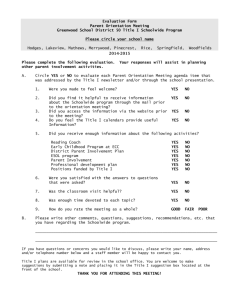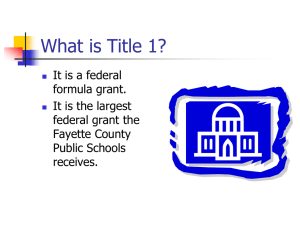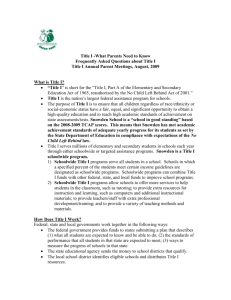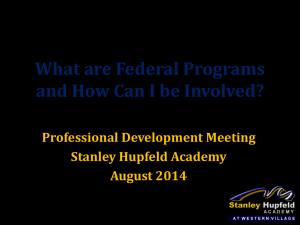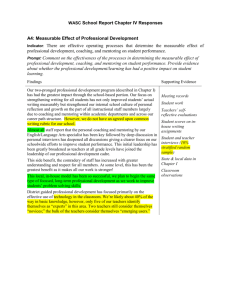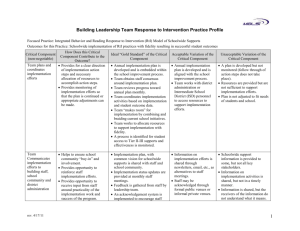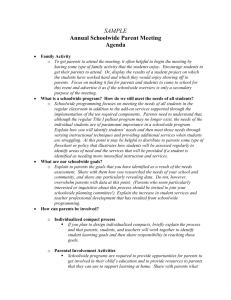WASC Self Study – 2010 Indicators
advertisement
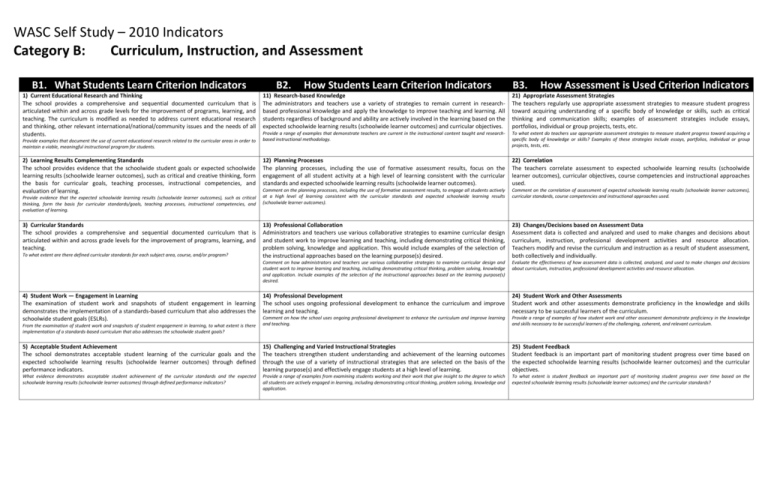
WASC Self Study – 2010 Indicators Category B: Curriculum, Instruction, and Assessment B1. What Students Learn Criterion Indicators 1) Current Educational Research and Thinking The school provides a comprehensive and sequential documented curriculum that is articulated within and across grade levels for the improvement of programs, learning, and teaching. The curriculum is modified as needed to address current educational research and thinking, other relevant international/national/community issues and the needs of all students. B2. How Students Learn Criterion Indicators B3. How Assessment is Used Criterion Indicators 11) Research-based Knowledge The administrators and teachers use a variety of strategies to remain current in researchbased professional knowledge and apply the knowledge to improve teaching and learning. All students regardless of background and ability are actively involved in the learning based on the expected schoolwide learning results (schoolwide learner outcomes) and curricular objectives. 21) Appropriate Assessment Strategies The teachers regularly use appropriate assessment strategies to measure student progress toward acquiring understanding of a specific body of knowledge or skills, such as critical thinking and communication skills; examples of assessment strategies include essays, portfolios, individual or group projects, tests, etc. Provide a range of examples that demonstrate teachers are current in the instructional content taught and researchbased instructional methodology. To what extent do teachers use appropriate assessment strategies to measure student progress toward acquiring a specific body of knowledge or skills? Examples of these strategies include essays, portfolios, individual or group projects, tests, etc. 12) Planning Processes The planning processes, including the use of formative assessment results, focus on the engagement of all student activity at a high level of learning consistent with the curricular standards and expected schoolwide learning results (schoolwide learner outcomes). 22) Correlation The teachers correlate assessment to expected schoolwide learning results (schoolwide learner outcomes), curricular objectives, course competencies and instructional approaches used. Comment on the planning processes, including the use of formative assessment results, to engage all students actively at a high level of learning consistent with the curricular standards and expected schoolwide learning results (schoolwide learner outcomes). Comment on the correlation of assessment of expected schoolwide learning results (schoolwide learner outcomes), curricular standards, course competencies and instructional approaches used. 13) Professional Collaboration Administrators and teachers use various collaborative strategies to examine curricular design and student work to improve learning and teaching, including demonstrating critical thinking, problem solving, knowledge and application. This would include examples of the selection of the instructional approaches based on the learning purpose(s) desired. 23) Changes/Decisions based on Assessment Data Assessment data is collected and analyzed and used to make changes and decisions about curriculum, instruction, professional development activities and resource allocation. Teachers modify and revise the curriculum and instruction as a result of student assessment, both collectively and individually. Comment on how administrators and teachers use various collaborative strategies to examine curricular design and student work to improve learning and teaching, including demonstrating critical thinking, problem solving, knowledge and application. Include examples of the selection of the instructional approaches based on the learning purpose(s) desired. Evaluate the effectiveness of how assessment data is collected, analyzed, and used to make changes and decisions about curriculum, instruction, professional development activities and resource allocation. 14) Professional Development The school uses ongoing professional development to enhance the curriculum and improve learning and teaching. 24) Student Work and Other Assessments Student work and other assessments demonstrate proficiency in the knowledge and skills necessary to be successful learners of the curriculum. Comment on how the school uses ongoing professional development to enhance the curriculum and improve learning and teaching. Provide a range of examples of how student work and other assessment demonstrate proficiency in the knowledge and skills necessary to be successful learners of the challenging, coherent, and relevant curriculum. 5) Acceptable Student Achievement The school demonstrates acceptable student learning of the curricular goals and the expected schoolwide learning results (schoolwide learner outcomes) through defined performance indicators. 15) Challenging and Varied Instructional Strategies The teachers strengthen student understanding and achievement of the learning outcomes through the use of a variety of instructional strategies that are selected on the basis of the learning purpose(s) and effectively engage students at a high level of learning. 25) Student Feedback Student feedback is an important part of monitoring student progress over time based on the expected schoolwide learning results (schoolwide learner outcomes) and the curricular objectives. What evidence demonstrates acceptable student achievement of the curricular standards and the expected schoolwide learning results (schoolwide learner outcomes) through defined performance indicators? Provide a range of examples from examining students working and their work that give insight to the degree to which all students are actively engaged in learning, including demonstrating critical thinking, problem solving, knowledge and application. To what extent is student feedback an important part of monitoring student progress over time based on the expected schoolwide learning results (schoolwide learner outcomes) and the curricular standards? Provide examples that document the use of current educational research related to the curricular areas in order to maintain a viable, meaningful instructional program for students. 2) Learning Results Complementing Standards The school provides evidence that the schoolwide student goals or expected schoolwide learning results (schoolwide learner outcomes), such as critical and creative thinking, form the basis for curricular goals, teaching processes, instructional competencies, and evaluation of learning. Provide evidence that the expected schoolwide learning results (schoolwide learner outcomes), such as critical thinking, form the basis for curricular standards/goals, teaching processes, instructional competencies, and evaluation of learning. 3) Curricular Standards The school provides a comprehensive and sequential documented curriculum that is articulated within and across grade levels for the improvement of programs, learning, and teaching. To what extent are there defined curricular standards for each subject area, course, and/or program? 4) Student Work — Engagement in Learning The examination of student work and snapshots of student engagement in learning demonstrates the implementation of a standards-based curriculum that also addresses the schoolwide student goals (ESLRs). From the examination of student work and snapshots of student engagement in learning, to what extent is there implementation of a standards-based curriculum that also addresses the schoolwide student goals? WASC Self Study – 2010 Indicators Category B: Curriculum, Instruction, and Assessment B1. What Students Learn Criterion Indicators 6) Curricular Review, Revision, and Evaluation The school implements a regular cycle of curriculum review and evaluation that leads to further curricular development and revision for the purpose of improving learning and teaching. Comment on the curriculum review, evaluation, and review processes for your program area and its impact on providing a challenging, coherent, and relevant curriculum for all students. B2. How Students Learn Criterion Indicators 26) Teacher Monitoring Teachers monitor student progress over time and use student feedback as appropriate to determine whether course objectives have been met. Comment on the integration of technology within the school so that all students develop a wide range of technological skills. How do teachers regularly monitor student progress over time and use student feedback as appropriate to determine whether curricular standards have been met? 17) Evidence of Results based upon Challenging Learning Experiences Students working and their work demonstrate critical and creative thinking, problem solving, knowledge attainment, and application skills. Comment on the collaborative strategies used to examine curriculum design and student work and its effect on refining lessons, units and/or courses. Comment on the student work and how it demonstrates critical and creative thinking, problem solving, knowledge attainment, and application skills. 8) Accessibility of all Students to Curriculum All students have accessibility to a challenging, relevant, and coherent curriculum. 18) Perception of Students Through interview and dialogue with students representative of the school population able to share their level of understanding of the expected level of performance based on the standards and the schoolwide learning results and their perceptions of their learning experiences. Comment on the level of understanding of representative students of the expected level of performance based on the standards and the schoolwide learning results and their perceptions of their learning experiences. 9) Policies — Rigorous, Relevant, Coherent Curriculum There are clear policies regarding course completion, certification, credits, grades, homework, etc. that guide student progression through the program. 19) Student Needs Teachers address various learning styles and student needs through the instructional approaches used. What have you learned about the curriculum and its rigor, relevancy and coherency after examination of policies regarding course completion, credits, grading policies, homework, etc.? How do teachers address the variety of ways in which students learn and their individual needs through instructional approaches appropriate for the subject? 10) Articulation and Follow-up Studies The school conducts student follow-up studies that provide insight to the effectiveness of the instruction to prepare students for pursuing further education, entering the work force, or meeting their personal goals. 20) Student Use of Resources Students use resources for learning beyond the limits of the textbook such as effective use of collaborative activities, technology, library/media resources and community resources. Share examples of articulation with feeder schools and local colleges and universities, including comments on the regularity of their occurrence. What has been revealed through the follow-up studies of graduates and others regarding the effectiveness of the curricular program? How Assessment is Used Criterion Indicators 16) Technological Integration Teachers systematically integrate technology within the school so that all students develop a wide range of technological skills. 7) Collaborative Work The administrators and teachers use various collaborative strategies to examine curriculum design and student work in order to refine lessons, units and/or courses. What have you learned about the accessibility of a challenging, relevant and coherent curriculum to all students? What have you learned from examining the demographics and distribution of students throughout the class offerings, e.g., master class schedule and class enrollments? B3. To what extent do students use resources for learning beyond the limits of the textbook such as effective use of technology, collaborative activities, and community resources?
